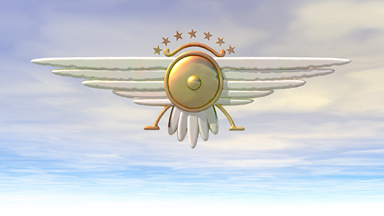
The Chariot of the gods

 Almost
all conjectures on the solar winged disk is that it represents a solar
eclipse, thus the reference solar disk. The wings are supposed to
represent the sun's corona during this event. This symbol early on made
its way to Egypt as two
symbols.
One as the eye of Horus (which, by the
way, became the Masonic symbol of the all-seeing eye atop the pyramid
on our dollar bill) and as the god Horus - a disk with out stretched
wings. Both of these symbols are also associated with Ra. His most
familiar form is that of the falcon headed god. The gods of Egypt, as
the association between Horus and Ra show, had a fluidity
whereby
they assumed different roles within the pantheon. This due in part to
the political climate.
Almost
all conjectures on the solar winged disk is that it represents a solar
eclipse, thus the reference solar disk. The wings are supposed to
represent the sun's corona during this event. This symbol early on made
its way to Egypt as two
symbols.
One as the eye of Horus (which, by the
way, became the Masonic symbol of the all-seeing eye atop the pyramid
on our dollar bill) and as the god Horus - a disk with out stretched
wings. Both of these symbols are also associated with Ra. His most
familiar form is that of the falcon headed god. The gods of Egypt, as
the association between Horus and Ra show, had a fluidity
whereby
they assumed different roles within the pantheon. This due in part to
the political climate.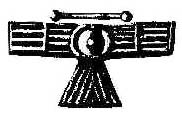
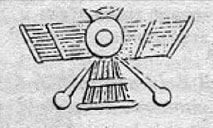 Here
are two of the many different and stylized
depictions of the solar
winged disk. These happen to be more mechanical in
appearance. Usually the wings are
much more avian by having feathered wings. The central hub of
the
solar winged disk is the "pointy object". What we are looking at is a
solid
three dimensional object as in "...of the bright pointed object"
(which will be discussed shortly).
The bottom "feathers" may be a stylized rendering of the rays
that radiate downward from the solar winged disk especially to the Tree
of Life. In the Egyptian version these "feathers" are absent leading to
the conclusion that what historians think are feathers may be something
different.
Here
are two of the many different and stylized
depictions of the solar
winged disk. These happen to be more mechanical in
appearance. Usually the wings are
much more avian by having feathered wings. The central hub of
the
solar winged disk is the "pointy object". What we are looking at is a
solid
three dimensional object as in "...of the bright pointed object"
(which will be discussed shortly).
The bottom "feathers" may be a stylized rendering of the rays
that radiate downward from the solar winged disk especially to the Tree
of Life. In the Egyptian version these "feathers" are absent leading to
the conclusion that what historians think are feathers may be something
different.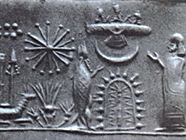

 These
two Sumerian cylinder impressions show how solar rays are depicted.
Both have
the holiest symbols, those in these impressions are the sun, moon,
winged disk and sometimes included the seven orbs which most likely are
the known planets. One has the solar winged disk directly above the
tree of
life by which stands the Babylonian Oannes (Ea also known as Enki in
Sumerian). One has the "tail
feathers" as rays just like the sun to it's
right. The black and white illustration is the symbol of Aten an
Egyptian sun god. Aten, or Aton, was the solar disk that Akhenaten
worshiped with the rays being the life-giving force of light.
These
two Sumerian cylinder impressions show how solar rays are depicted.
Both have
the holiest symbols, those in these impressions are the sun, moon,
winged disk and sometimes included the seven orbs which most likely are
the known planets. One has the solar winged disk directly above the
tree of
life by which stands the Babylonian Oannes (Ea also known as Enki in
Sumerian). One has the "tail
feathers" as rays just like the sun to it's
right. The black and white illustration is the symbol of Aten an
Egyptian sun god. Aten, or Aton, was the solar disk that Akhenaten
worshiped with the rays being the life-giving force of light.
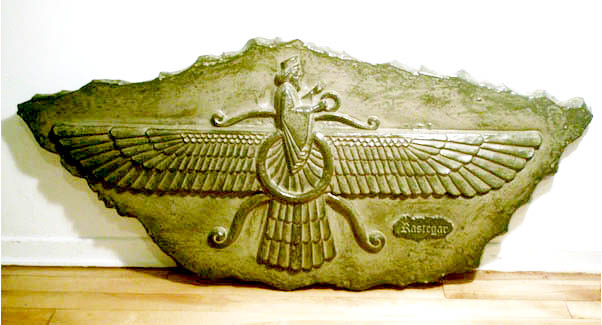 There
is another
component to
this structure and that is the bar positioned above the wings.
Sometimes it is shown with the bar being curved.
There
is another
component to
this structure and that is the bar positioned above the wings.
Sometimes it is shown with the bar being curved.Later illustrations delete this feature and for the most part it does not show up in the Egyptian winged disks. What this bar represents is pure speculation. It may have something to do with the winged panels. It's purpose may be to retract and extend the panels as necessary. Also these panels may fold. Or it may be an indication of a latch or door to the hub. This is the vehicle that traveled from heaven by which the ancient Sumerians say "Kingship was lowered from heaven". The faravahar to immediate left as usually shown. Note top bar above the wings.
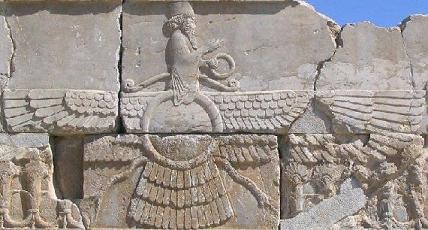


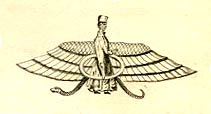
 Continuing
with the mechanical nature of the solar
winged disk, this discussion
includes the "feet" at the bottom as extensions from the rim. The foot
on
the bottom appendage of
this faravahar looks a lot like a
bird's foot.
This is where the Egyptians substituted the serpent ureaus.
This
appendage for
whatever it is, seems to always be attached to the rim of the disk.
The ureaus is always attached to the disk with or without
wings.
The
Egyptians made these
appendages into the ureaus, the cobra of
Lower Egypt. These
uraei represent the "fiery eyes of Re". The
ureaus was believed to spit fire.
This appendage seems to
appear flexible and that may give it its serpentine appearance.
Many of the solar winged disks display a curling of the feet and the
top bar as well. This may mean there is a relationship
between the top bar and the lower extended appendages despite the
differing renderings.
Continuing
with the mechanical nature of the solar
winged disk, this discussion
includes the "feet" at the bottom as extensions from the rim. The foot
on
the bottom appendage of
this faravahar looks a lot like a
bird's foot.
This is where the Egyptians substituted the serpent ureaus.
This
appendage for
whatever it is, seems to always be attached to the rim of the disk.
The ureaus is always attached to the disk with or without
wings.
The
Egyptians made these
appendages into the ureaus, the cobra of
Lower Egypt. These
uraei represent the "fiery eyes of Re". The
ureaus was believed to spit fire.
This appendage seems to
appear flexible and that may give it its serpentine appearance.
Many of the solar winged disks display a curling of the feet and the
top bar as well. This may mean there is a relationship
between the top bar and the lower extended appendages despite the
differing renderings.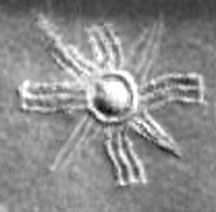
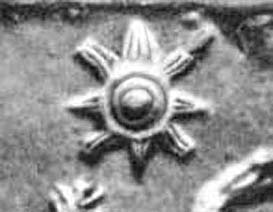
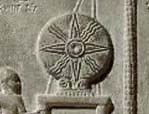
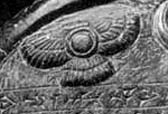
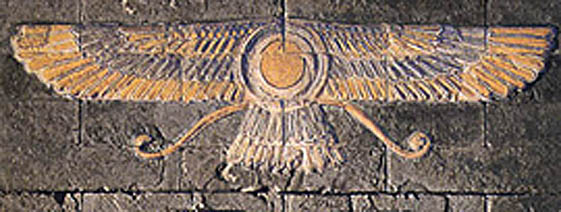 This
is an unusual display of the solar winged disk. It shows four wings and
four "flames" giving it the eight spoke design. The hub is prominent in
this depiction. It is this symbol that became associated, usurped,
by the sun
god Shamash. The second picture shows
the solar winged disk
again with
four
panels and four "flames".
The third picture shows the image of Shamash
as a sun disk. Thus the solar winged disk was represented by the
sun
god Shamash and by the bird
like solar winged disk itself as
it appeared in the sky apart from Shamash. The forth
(Babylonian) and fifth (Persian) are more of the
bird-like renderings.
This
is an unusual display of the solar winged disk. It shows four wings and
four "flames" giving it the eight spoke design. The hub is prominent in
this depiction. It is this symbol that became associated, usurped,
by the sun
god Shamash. The second picture shows
the solar winged disk
again with
four
panels and four "flames".
The third picture shows the image of Shamash
as a sun disk. Thus the solar winged disk was represented by the
sun
god Shamash and by the bird
like solar winged disk itself as
it appeared in the sky apart from Shamash. The forth
(Babylonian) and fifth (Persian) are more of the
bird-like renderings. Every
once in a while something unexpected shows up. This is the case of the
cylindar to the left. All the Faravahars I have seen to date have been
the two wing variety. This one has four wings and is a truer depiction
of the winged disk in its more bird like display.
Every
once in a while something unexpected shows up. This is the case of the
cylindar to the left. All the Faravahars I have seen to date have been
the two wing variety. This one has four wings and is a truer depiction
of the winged disk in its more bird like display.
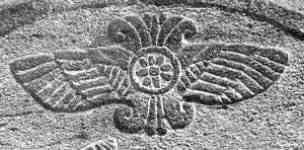 Not
only did celestials use these transports to travel across the vast
distances of interstellar space but the tree of life was brought to
this planet by these same transporters, these "fiery serpents" the
seraphim. In
Hebrew seraphim means "fiery angels" and "burning ones".
Not
only did celestials use these transports to travel across the vast
distances of interstellar space but the tree of life was brought to
this planet by these same transporters, these "fiery serpents" the
seraphim. In
Hebrew seraphim means "fiery angels" and "burning ones". The solar winged disk with the rosette in the center is representing the tree of life. In Sumerian art the solar winged disk is usually shown hovering over the Tree of Life.
And it may also be that the myths of the serpent is related to these enigmatic Din.Girs with the associated wisdom that serpents have in the ancient texts. These myths and legends are not that far away from our own culture. Ever wonder where dragons - serpents - that fly and breathed fire came from? Legends are powerful stuff.
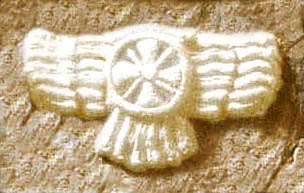
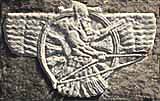 The
solar winged disk
was not only a "sharp pointed object" that traveled the sky, it was a
potent
iconic carrier
of cultural values and themes. As the rosette/disk above so were other
cultural identities attached to the disk. The heavier cross in the
circle is the symbol of Anu but the added thinner cross members imparts
another meaning and that is the symbol for Shamash.
The
Assyrians created the Ashur/disk icon which made its way eastward to
what is today Iran. It may be through the faravahar that the idea
of winged messengers, angels, came to be incorporated into the
Christian religion.
The
solar winged disk
was not only a "sharp pointed object" that traveled the sky, it was a
potent
iconic carrier
of cultural values and themes. As the rosette/disk above so were other
cultural identities attached to the disk. The heavier cross in the
circle is the symbol of Anu but the added thinner cross members imparts
another meaning and that is the symbol for Shamash.
The
Assyrians created the Ashur/disk icon which made its way eastward to
what is today Iran. It may be through the faravahar that the idea
of winged messengers, angels, came to be incorporated into the
Christian religion.
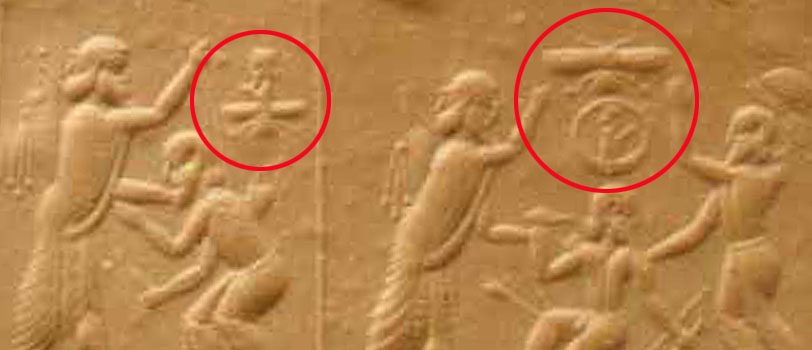 To the left is a cylinder
impression that has two different representations of the solar winged
disk. On the left side of the impression is the Faravahar
which is represented in both Assyrian
and Iranian art and to the right a traditional rendering of the winged
disk. Just beneath this winged disk is an embossed circle with what
probably is the king
inside. This is most likely a representation of showing the king within
the solar winged
disk much like the photo inset we are so familiar with
today. What is interesting is that both of these images
are shown at
the same time. Why is a matter of conjecture. Maybe the
ancients were playing it safe and included both representations.
To the left is a cylinder
impression that has two different representations of the solar winged
disk. On the left side of the impression is the Faravahar
which is represented in both Assyrian
and Iranian art and to the right a traditional rendering of the winged
disk. Just beneath this winged disk is an embossed circle with what
probably is the king
inside. This is most likely a representation of showing the king within
the solar winged
disk much like the photo inset we are so familiar with
today. What is interesting is that both of these images
are shown at
the same time. Why is a matter of conjecture. Maybe the
ancients were playing it safe and included both representations. Wings,
another
prehistoric idea alive today. Wings have always indicated divinity. The
Urantia Book has a description of the seraphic transporters (p.438) -
seraphim -
which reveals the fact that humans have been allowed to see these
transporters. Also included is how we came to believe angels have wings
which actually are a double set of protective shields and that the
transporters change shape to become pointed and shine with luminosity.
"A bright and pointed object" indeed. As an aside to this discussion on
wings, angels got their wings only well into the Christian era. Only
Cherubim and Seraphim had multiple wings in the Old Testament and they
were never strictly angels as we understand the term. In reading the OT
descriptions of angels, they were human like and devoid of wings. In
some cases very human like.
Wings,
another
prehistoric idea alive today. Wings have always indicated divinity. The
Urantia Book has a description of the seraphic transporters (p.438) -
seraphim -
which reveals the fact that humans have been allowed to see these
transporters. Also included is how we came to believe angels have wings
which actually are a double set of protective shields and that the
transporters change shape to become pointed and shine with luminosity.
"A bright and pointed object" indeed. As an aside to this discussion on
wings, angels got their wings only well into the Christian era. Only
Cherubim and Seraphim had multiple wings in the Old Testament and they
were never strictly angels as we understand the term. In reading the OT
descriptions of angels, they were human like and devoid of wings. In
some cases very human like.
 A
double set of wings is the norm for depicting the genii. Seraphim in
the Bible have a set of six wings. The first smaller picture is
Cyrus-as-seraphim. The second is Hittite. In all cases the double set
of wings have the traditional "X" shape, two up two down the same as on
the earlier solar winged disk. Two wings up also is used in the six
wing presentation.
A
double set of wings is the norm for depicting the genii. Seraphim in
the Bible have a set of six wings. The first smaller picture is
Cyrus-as-seraphim. The second is Hittite. In all cases the double set
of wings have the traditional "X" shape, two up two down the same as on
the earlier solar winged disk. Two wings up also is used in the six
wing presentation."The Sumerians included "messengers of the Gods" who ran errands between gods and humans. This is the earliest recorded evidence of a type of Angel. These beings influenced Sumerian poetry, the arts, and religions. Each Sumerian home had an altar honoring their Guardian Angel. Excavations near the Sumerian capital of UR revealed religious artifacts. One of the earliest discovered Angel engraving in stone was a winged figure from heaven pouring the water of life into the king's cup. Temple walls and the entrances to palaces had painted protectors of winged beings who were also worshiped and were similar to the cherubim and seraphim of today.
Zoroaster stated that the Lord of Light and his Archangels had a nemesis - the Lord of Darkness with supportive demons and evil spirits. There was a concept of a major battle between these forces of dark and light, however, Zoroaster had faith that the Lord of Light and his Angels would be victorious. Angels played a major role in the beliefs of the the Zoroastrians, and many similar philosophies regarding Angels are seen in other religions.
Both before and after the Jewish exile, their view of Angels were influenced by the Zoroastrians. The amount of their Angels increased and they became messengers of the Divine. Their Jewish scriptures tell of the Angelic war between good and devil which result in the world's end. This sounds like the Zoroastrian fight of the Lord of Darkness and Light. However, some Jewish leaders rejected these writings. Many of the Angels adopted by the Jewish writings (influenced by Zoroaster) became similar to the Christan concept of Angels. Each country having an Archangel protecting it is mentioned in the Book of Daniel." ( http://members.aol.com/_ht_a/Webangelgt/angelhistory.html) Copyright Angelight 1999. Webangelgt@aol.com
Genesis
6:1-4
"1 When men began to increase in number on the earth and daughters were
born to them, the
2 sons of God (Watchers) saw that the daughters of
men were beautiful, and they married (or cohabitated with) any of them
they chose.
3 Then the LORD said, "My Spirit will not contend with man forever, for
he is mortal; his days will be a hundred and twenty years."
4 The Nephilim (giants=earth born, the fallen) were
on the earth in those days - and also afterward - when the sons of God
went to the daughters of men and had children by them. They were the heroes
of old (mighty ones of eternity), the men of renown
(people of the shem)."
Revised Standard Version
People
of the Shem
"The shem was also
closely
linked with fire and a stone; the shem thus was a ‘high ward
fire-stone’. It is, in other words, apparently a reference to
a meteorite. This is strongly corroborated by the fact that: Shems were
particularly associated with something called an-na, which meant
‘heavenly stone’, a term that was also used to
define a shining metal. The use of the word shem in respect of its
‘shining’ aspect is apparent in the alternative
name for Prince Utu, brother of Inanna… His epithet was
Shem-esh: the Shining One. (Laurence Gardner, Genesis of the Grail
Kings, p.120)
So,
what we have here is this: the shem was a ‘heavenly
shining
fire-stone’ while the Nephilim, i.e. the ‘fallen
angles’ (also called the ‘Shining Ones’),
were the
‘people of the shem’."
(http://www.goroadachi.com/etemenanki/mystery-babylon.htm
)
People of the shem. This has nothing to do with Shem one of the sons of Noah. What I think it has to do with is the winged disk, the icon that this web site supports as the seraphic transport. References to "high ward", "shining metal" and "heavenly" point to something real that links the earth with heaven. Considerings the winged disk is one of the five top holiest symbols of the Assyrians and most likely Mesopotamia in general, the term shem being applied to the winged disk seems to fit. This is particularly true in context of the biblical statement connecting the nephilim with the people of the shem. The Urantia Book on p.742 states categorically that the Caligastia one hundred - the "Watchers" - arrived from "heaven" to earth by seraphic transport. Seraphims are the seraphic transporters and are also known biblically as fiery, flying serpents. In this case truth is stranger than fiction.
Except
for maybe Revelations, these four lines of Genesis are perhaps the most
enigmatic in the Bible. Here are the clues to a history that has been
deprived us. What still needs to be connected to the fallen/Watchers
story is the event that precipitated the fall of the celestials: the
Lucifer rebellion. In Revelations 12:7 the story of the fall of Lucifer
is revealed. Here are statements that the dragon (Lucifer) and his
angels were at war in heaven but they were defeated and were "thrown
down to the Earth" (thanks a lot). Along with the "great red dragon"
"His tail swept down a third of the stars [celestials] of heaven, and
cast them to the Earth" (Rev 12:4). The two stories of the Nephilim and
of Lucifer are separated by the entire Bible yet both stories share the
fallen-to-Earth scenario. These celestials were already here but were
cast down - or became fallen - as a result of the rebellion, once
super mortal now they became as man, they had become mortal: "My spirit
will not contend with man forever..." Lucifer's war was
one with the
most tragic of consequences. It was a war for the souls in heaven and
on earth. It was a war of true death, one which the vanquished became
as if they never were. Celestials just as mortals are endowed with free
will and the only supreme choice of free will is to survive. In the
Book of Enoch he (Enoch) is petitioned by the Watchers to intervene on
their behalf with the higher authorities. The reply was that they had
made their choice.
"4...and
in
my vision it appeared thus, that your petition will not be
granted unto you throughout all the days of eternity, and that judgment
5 has been
finally passed upon you: yea (your petition) will not be
granted unto you. And from henceforth you shall not ascend into heaven
unto all eternity, and in bonds of the earth the decree
6 has gone
forth to bind you for all the days of the world." - Enoch
14:4-6 (Yes, Virginia, there is
divine justice.)
 The Tree of Life and
the Ancients
The Tree of Life and
the Ancients